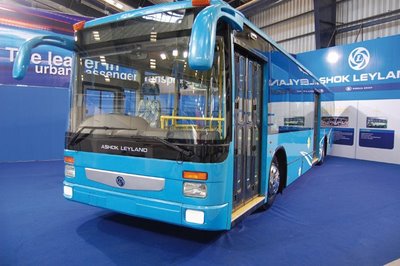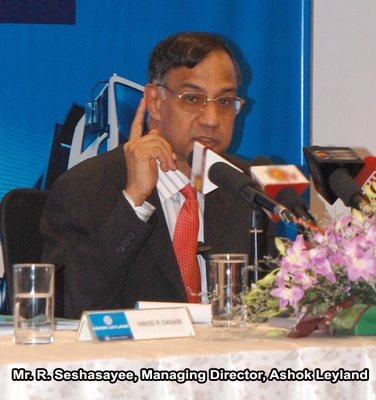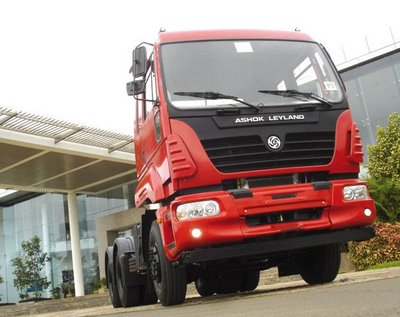 Withstanding a 33 per cent contraction in demand for medium and heavy-duty commercial vehicles, Ashok Leyland registered a net profit of Rs. 190 crores during 2008-09, keeping intact its profitable track record of 60 years. On a reduced sales volume of 54,431 vehicles against 83,307 units in 2007-08, the sales turnover is at Rs. 5,981.07 crores (Rs. 7,742.58 crores), with other income contributing Rs. 49.62 crores (Rs. 57.61 crores).
Withstanding a 33 per cent contraction in demand for medium and heavy-duty commercial vehicles, Ashok Leyland registered a net profit of Rs. 190 crores during 2008-09, keeping intact its profitable track record of 60 years. On a reduced sales volume of 54,431 vehicles against 83,307 units in 2007-08, the sales turnover is at Rs. 5,981.07 crores (Rs. 7,742.58 crores), with other income contributing Rs. 49.62 crores (Rs. 57.61 crores).
Faced with a steep fall in demand, Ashok Leyland curtailed production by resorting to lesser number of working days starting November 2008, which has brought down operating costs, contributing to lower “other expenses” at Rs. 493.21 crores (Rs. 541.20 crores). Employee costs during the year were contained at Rs. 566.18 crores (Rs. 616.09 crores). However, financial expenses rose to Rs. 118.71 crores (Rs. 49.74 crores), reflecting higher borrowings to meet capex commitments, higher working capital requirements and higher interest rates.
Profit before tax was lower at Rs. 208.45 crores (Rs. 638.15 crores) with income-tax claiming a lower Rs. 12.45 crores (Rs. 161.84 crores) and fringe benefit tax Rs. 6 crores (Rs. 6 crores). Net profit is Rs. 190 crores (Rs. 469.31 crores). Analyzing the composition of vehicle demand at a press conference in Chennai, Mr. R. Seshasayee, Managing Director, Ashok Leyland, said: “One disturbing trend in the segmental shift is the steeper fall in demand for higher capacity vehicles such as tractor trailers and multi-axle vehicles, at least temporarily, retarding the modernization of India’s vehicle composition. These are also segments where Ashok Leyland has a stronger presence and the maximum model options. This segmental reversal and the relatively robust demand in the eastern region impacted the company’s goods volumes”.
Analyzing the composition of vehicle demand at a press conference in Chennai, Mr. R. Seshasayee, Managing Director, Ashok Leyland, said: “One disturbing trend in the segmental shift is the steeper fall in demand for higher capacity vehicles such as tractor trailers and multi-axle vehicles, at least temporarily, retarding the modernization of India’s vehicle composition. These are also segments where Ashok Leyland has a stronger presence and the maximum model options. This segmental reversal and the relatively robust demand in the eastern region impacted the company’s goods volumes”.
The first six months began normally with just two per cent drop compared to the previous year. The fall in the second quarter was quite dramatic. But this fall was expected as there is cyclicality in this industry. “We had too many good years, and one would have expected that the cycle must correct itself. But clearly the suddenness and severity of this downfall was completely unanticipated. October 2008 saw a 65 per cent drop in volumes, and we ended the whole year with a drop of 35 per cent”.
He said the redeeming feature was the bus demand which was down just 9.7 per cent. The company improved its market share in buses by 0.5 per cent and retained the No.1 position.
Overall, the share of non-cyclical business moved up to 50 per cent from 34 per cent in 2007-08, with the engines business fetching a revenue of Rs. 404 crores (Rs. 204 crores). This represented a higher volume of genset engines (11,264 units) and transformation of the business stream from mere trading in engines into ‘the Power Solutions Business’ through greater value addition.
Mr. Seshasayee further observed that the slowdown forced a quick redrawal of the capex plans. Investment plan for 2009-12 has been scaled down from Rs. 3,000 crores to Rs. 2,000 crores, yet protecting product development outlay. While the additional 20,000 engine capacity at Ennore is on ground and the Ras Al Khaimah bus plant is operational, the Uttarkhand unit will go on stream with an initial capacity of 50,000 vehicles by the end this fiscal.
He was happy to point out that the various austerity and efficiency improvement measures resulted in a saving of Rs. 90 crores. “We have also re-built a few hundred vehicles which were lying unsold in the stockyard into saleable units. This was a massive rebuilding program which was unprecedented and was successfully carried out”.
Work on the company’s joint venture with John Deere for construction equipment is in progress. As for the light trucks JV with Nissan, with respect to the various products, development activity is on track and on schedule. Under consideration is optimization of investments by making use of the existing facilities of both the partners.
The two partners are also evaluating the possibility of enlarging the product range in the manufacturing plan, including some additional products from Nissan’s global portfolio of light commercial vehicles. The economic slowdown and the delay in land acquisition together have pushed the project dates back around six months. The current assumption for start of volume production is 2011.
The Managing Director said that the company has developed two versions of the new generation Neptune engines in partnership with AVL Austria: the 4 cylinder engine in the 160-230 hp range and the 6 cylinder engine in the 270-380 hp range. The Neptune engine will power the modern truck range to be built on the modular UNITRUCK platform, to be launched in April 2010. The Product Development at Ashok Leyland is currently under migration to GENMOD, the transformational matrix management process with breakthrough performance targets for future vehicles. Ashok Leyland is also extending its lean management initiatives to Marketing. Under its new working capital management initiative, pipeline inventories are being reduced through various measures, including warehouse rationalization.
Ashok Leyland is also extending its lean management initiatives to Marketing. Under its new working capital management initiative, pipeline inventories are being reduced through various measures, including warehouse rationalization.
The company has so far received orders totalling over 2,800 buses out of the total orders for 5,330 buses released under JNNURM. Out of over 14,000 buses sanctioned, tenders have been released for over 11,200 units.
Touching on the 2009-10 outlook, Mr. Seshasayee said the overall recovery is dependent on revival of economic activity and political stability, re-start of stalled infrastructure development projects, fillip to the housing and construction segments and rapid implementation of the JNNURM-funded projects.
